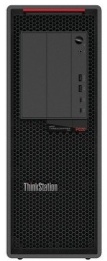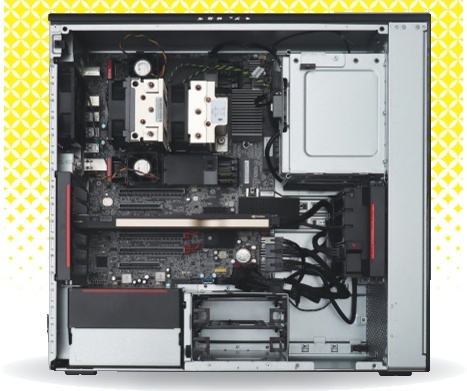Why you can trust TechRadar
This review first appeared in issue 348 of PC Pro.
We haven’t seen many blue-chip brands in our workstation Labs for some years. This has largely been because these manufacturers stuck with Intel Xeons, even when AMD was in the ascendancy, so wouldn’t have fared well. But Lenovo has been offering the AMD alternative for some years and was the initial partner for the Ryzen Threadripper Pro when it arrived last year. Now we get our first look at what Lenovo can do with this potent CPU.
The system is based on the AMD Ryzen Threadripper Pro 5945WX, which has the lowest number of cores of any CPU this month – just 12. These run at a base 4.1GHz and boost 4.5GHz, with multithreading and support for eight-channel memory. But Lenovo only provides four 3,200MHz DDR4 DIMM modules, so the bandwidth is quad channel with half the throughput of eight-channel, even though the total was a wholesome 64GB.
Lenovo offers a choice of AMD and Nvidia graphics with the P620, and our system came with Nvidia’s RTX A4000. This places this configuration as a modelling workstation rather than more general purpose. Lenovo was IBM’s hardware manufacturer, and when IBM became a services company Lenovo inherited its server and workstation business. The chassis is still reminiscent of the former brand, with excellent tool-free design.

In this high-powered company, the P620 fell behind, achieving 529 in the media-focused benchmarks, 21,580 in the Cinebench R23 multicore rendering test and 486 seconds for the Blender CPU render. These would have been amazing scores a year ago, but all other systems here are way ahead. The Adobe Media Encoder results were impressive, however, taking 121 seconds with CUDA acceleration enabled.
Although the Threadripper Pro has a solid 4.5GHz top single-core frequency, this clearly held it back when modelling. The SPECviewperf 2020 v3.1 results were excellent on an absolute scale but were beaten by every other system. The 2TB Samsung PM981ab was also the slowest NVMe drive here, delivering just 3,519MB/sec reading and 2,986MB/sec writing.
It’s hard to mark down the Lenovo P620 Tower for lagging behind in performance. It’s the cheapest system in this labs test by nearly £900 inc VAT and if upgraded to £4,500 would be far more competitive. It’s also a solid, well-built workstation. With the right specification for your money, it could be well worth considering.
Dr James Morris has worked as a technology journalist for over 25 years, including spending nine years on the staff of market-leading computer magazine PC Pro, the last five of which were as the publication’s editor. He specializes in enterprise-grade software and hardware, with a particular focus on content creation.
What is a hands on review?
Hands on reviews' are a journalist's first impressions of a piece of kit based on spending some time with it. It may be just a few moments, or a few hours. The important thing is we have been able to play with it ourselves and can give you some sense of what it's like to use, even if it's only an embryonic view. For more information, see TechRadar's Reviews Guarantee.
You must confirm your public display name before commenting
Please logout and then login again, you will then be prompted to enter your display name.

